TyppiHappo
Harmless

Posts: 8
Registered: 11-11-2021
Member Is Offline
|
|
Synthesis of Lanthanum(III) acetylacetonate
Hello! I’ve just registered to the forum and I’m happy to share my experience.
I wanted to report a synthesis I tried about a month ago, and I’d like to know if somebody has idea of what happened. My aim was to make
lanthanum(III) acetylacetonate, and I was following this paper:
https://d.lib.msu.edu/etd/4927/datastream/OBJ/view
What I did:
I dissolved 1.495 g of 99.995% pure lanthanum(III) oxide in dilute HCl and brought the pH to about 5 by adding dilute ammonia solution.
La2O3 + 6 HCl --> 2 LaCl3 + 3 H2O
I prepared a water solution of ammonia and acetylacetone, with a 50% excess of acetylacetone. I started adding 4.25 mL of acetylacetone in a beaker
and then added about 2.8 mL of 23% ammonia. This mixture solidified and this could be, in my opinion, the main cause of the low yield. I then added
water, and the solid dissolved (with the help of low heating). I should have added water before adding ammonia. Total volume was 25 mL with a slightly
yellow color.
When I was ready, I dumped the solution of acetylacetone and ammonia in the lanthanum(III) chloride, with stirring. The reaction I would expect is:
LaCl3 + 3 Hacac + 3 NH3 --> La(acac)3 + 3 NH4Cl
The solution turned a bright yellow after few seconds and after less than a minute, a precipitate started to form.
I let the mixture stir for some hours and then rest for 12 hours.
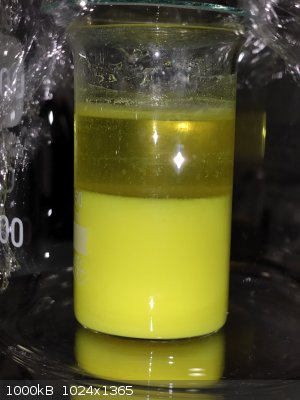
The next day I vacuum-filtered the solid and put in a desiccator over NaOH.
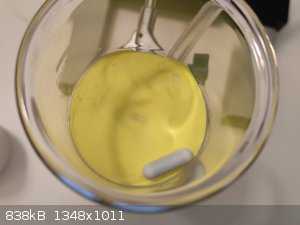
The dry solid weighed 3.04 g. It was bright yellow in color, and under long-wave UV light it was strongly fluorescent (green). It was very similar to
the mineral autunite in both color and fluorescence.
Some weeks later, I decided to try recrystallizing the compound. I dissolved all of the solid in about 40 mL of hot (almost boiling) 99% ethanol with
a few drops of acetone. The solution was slightly turbid.
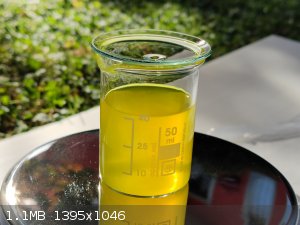
On cooling, a fine crystalline precipitate formed.
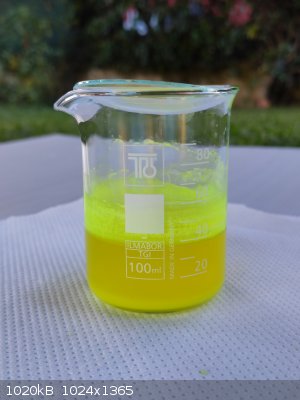
The mixture was then placed in an ice bath. A lot of needle-shaped yellow crystals formed.
When I vacuum-filtered the mixture, the fine crystals passed through the filter, while the needle-shaped crystals did not. All the solids and the
solution were yellow at this point.
I took the filtrate with the fine crystals and washed them with lots of water until the material looked white (the yellow byproduct is somewhat
soluble in water). I placed the crystalline solid in the desiccator and when dry put it in a vial. This is the lanthanum(III) acetylacetonate. It is
white and non-fluorescent. It still has minor fluorescent impurities but not much.
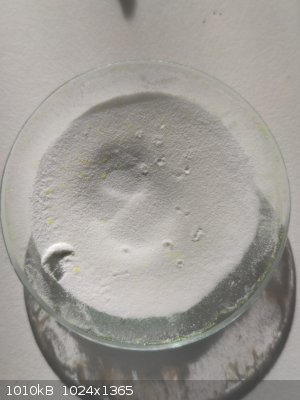
The yellow needles were scraped off the filter, left to dry in the air for some minutes and put in a vial. This byproduct is bright yellow and
fluorescent (like I described before, resembles autunite). I don’t know what this compound could be.
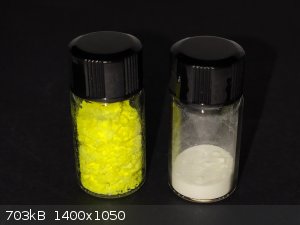 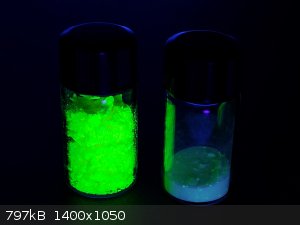
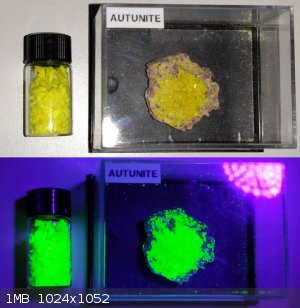
I obtained 0.393 g of La(acac)3 which is a 9.8% yield.
I obtained 1.32 g of the yellow compound.
Can anyone help me identify this yellow compound?
|
|
|
Boffis
International Hazard
    
Posts: 1836
Registered: 1-5-2011
Member Is Offline
Mood: No Mood
|
|
Hi TippiHappo, I am not sure I can answer your problem completely but having read the linked thesis and your description and the one thing that comes
to mind immediately is the mixing of acetylacetone with conc. ammonia. You report that it solidified! This is not surprising consider the reaction of
ammonia and acetone (much reported on in this forum as a route to TEMPO). The methylene group between the carbonyls probably makes it even more
reactive the the CH3 group in acetone particularly as it is enolised. I don't know what the produce will be but I suggest first of all burn a little
of the yellow product to see if it contains lanthanum. So I agree with your assessment that the formation of the solid on mixing the ammonia and
acetylacetone and particularly warming it may be the cause of you problem.
Have you tried repeating the synthesis using more dilute ammonia, keep the ammonia acetylacetone solution cold and use immediately.
Finally mix some ammonia with acetylacetone and simply leave it to stand in a warm place to see if there is a similar reaction. Was your solid that
formed on mixing yellow or white.
Ah, just done a Google Scholar search on the "reaction of ammonia with acetylacetone" and it appears that this reaction is used for the fluorometric
detection of formaldehyde, ammonia and other carbonyls. It is known as the Hantzsch dihydropyridine synthesis!!!
Soooo. I think my suggestions about about keeping things cold and working quickly may be the key.
[Edited on 13-11-2021 by Boffis]
Take a look at these two papers attached below. I think they may offer some insight into the potential side reaction you are experiencing.
Incidentally, when reading the original paper you posted again I notice that the Ce3+ acetylacetonate was described as yellow when those of lanthanum
and samarium white or cream. Maybe his Ce compound was also contaminated.
[Edited on 13-11-2021 by Boffis]
Attachment: Colourimetric estimation of formaldehyde by means of the Hantzsch reaction BiochemJ Nash 1953.pdf (863kB)
This file has been downloaded 215 times
Attachment: The reaction of ammonia and aliphatic amines with uranyl acetylacetonate InNuclC Haigh & Thornton 1971.pdf (504kB)
This file has been downloaded 215 times
|
|
|
Boffis
International Hazard
    
Posts: 1836
Registered: 1-5-2011
Member Is Offline
Mood: No Mood
|
|
Tippihappo, is it possible that you acetylacetone is contaminated with a little aldehyde? particularly formaldehyde.
Your yellow compound sound exactly like the condensation product of acetylacetone, ammonia and formaldehyde;
2,6-dimethyl-3,5-diacetyl-1,4-dihydropyridine which fluoresces an intense greenish yellow, acetaldehyde gives the 4-methyl analogue which fluoresces a
deeper green colour.
|
|
|
TyppiHappo
Harmless

Posts: 8
Registered: 11-11-2021
Member Is Offline
|
|
Hi Boffis, thank you very much of your answer.
I've tried burning a small piece of the solid, but what's left is a black material with some white spots.
Reading the paper you found about the Hantzsch reaction, it describes the compound formed by ammonia, acetylacetone and formaldehyde as I would
describe mine.
So probably a Hantzsch dihydropyridine synthesis occurred between three molecules of acetylacetone and ammonia? I also tried writing a mechanism and
it could work. This would be the product:
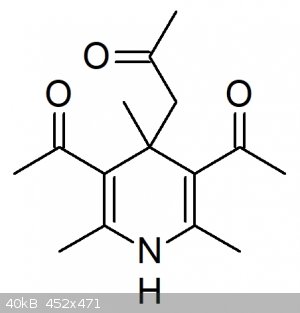
I don't think my acetylacetone would be so much contaminated to obtain such a high amount of the compound. It is from ChemCraft and on the label it
says >99.5%.
Anyway, I'll replicate the synthesis in the future but changing the REE (maybe Ce or Nd) and I will post the results.
|
|
|
unionised
International Hazard
    
Posts: 5104
Registered: 1-11-2003
Location: UK
Member Is Offline
Mood: No Mood
|
|
It might be interesting to mix a solution (perhaps in ethanol) of CeCl3 and AcAc with a solution of NaOH.
Then let the solvent evaporate and extract the product into ethanol + recrystalise it.
That way, ay deprotonated AcAc has the opportunity to react with the Ce before it does anything complicated.
|
|
|
TyppiHappo
Harmless

Posts: 8
Registered: 11-11-2021
Member Is Offline
|
|
Yes, this method with ammonia has the problem of the side reaction. I want to try again to see if the actual error was how I mixed acetylacetone and
ammonia, but this is not the best method for the synthesis of REE acetylacetonates if one is not careful.
For sure another base will do the work best. I've also seen using acetate.
With hydroxide I would keep it not too concentrate, and add it slowly checking the pH (as the thesis explains, there may be some basic product
forming).
|
|
|
woelen
Super Administrator
        
Posts: 7977
Registered: 20-8-2005
Location: Netherlands
Member Is Offline
Mood: interested
|
|
Maybe a metaborate or borax could be used as mild base, but I'm not sure whether these lead to precipitation of insoluble borates or mixed borate/acac
complexes. Too harsh bases indeed may lead to formation of basic products.
|
|
|
Boffis
International Hazard
    
Posts: 1836
Registered: 1-5-2011
Member Is Offline
Mood: No Mood
|
|
Hi TyppiHappo, have you tried just mixing the acetylacetone and ammonia and gently warming without any RE compound to see if you reproduce the colour.
I would try it myself but I am not at home at present.
|
|
|
TyppiHappo
Harmless

Posts: 8
Registered: 11-11-2021
Member Is Offline
|
|
I've just finished trying the reaction of acetylacetone and ammonia.
I poured 1 mL of acetylacetone in a glass vial and added 0.3 mL of 23% ammonia. This is a 3:1 molar ratio between acetylacetone and ammonia. A whitish
solid is formed immediately, and the mixture warms up a bit.
Depending on the light conditions and on the background, the material looks more whitish or more yellowish. It is soft.
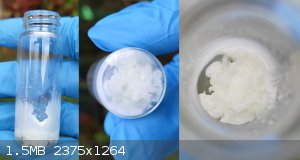 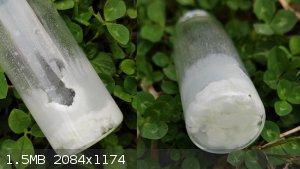
Next, I added some water (more than 10 mLs), and while stirring with a glass rod I heated the vial on the hot plate (low power).
The solid started dissolving forming an oil which was floating. After some minutes it all dissolved, producing a slightly yellow solution. The
temperature was about 40 °C.
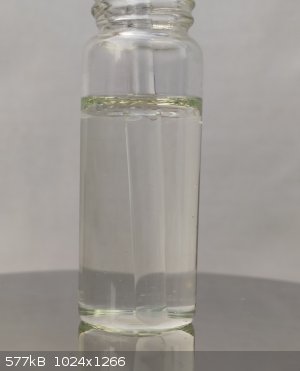
In this picture you can see some drops of the oil just under the surface of the liquid.
After few minutes I added again about 0.3 mL of ammonia, but nothing seemed to happen.
Now it's been about an hour and the solution looks the same.
If you are interested to see a video about the formation and the consistency of the white material as well as its dissolution in water let me know.
|
|
|
TyppiHappo
Harmless

Posts: 8
Registered: 11-11-2021
Member Is Offline
|
|
Ok, it's been about a day and the test solution is slightly more yellow, with a faint fluorescence under UV light.
When I made La(acac)3, the solution was kept at a pH of about 5, to prevent basic lanthanum products forming.
So I added to the test some drops of hydrochloric acid and mixed until the pH was about 5. The color changed to a vivid yellow, with green
fluorescence under UV light. This must be the same yellow compound I obtained with La(acac)3.
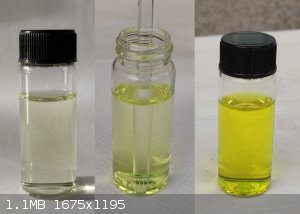
No precipitation until now. Maybe the solution is too diluted.
|
|
|
Boffis
International Hazard
    
Posts: 1836
Registered: 1-5-2011
Member Is Offline
Mood: No Mood
|
|
Mmm interesting, this does seem to support some kind of condensation between the ammonia and the acac. That it turns yellow when protonate does not
surprise me given the reported fluorescence of the related compounds.
One thing you might try is to oxidise a little of the compound in alkaline solution with hypochlorite and see if any chloroform is liberated. If your
structure above is correct (I came up with the same structure and I can't see any other possibility) you should be able to get 3 molar equivalences of
chloroform from each molar amount of you compound. You will probably need to recrystallise some of the yellow crystals to ensure they are free of acac
but you should be able to smell the chloroform easily. I am not sure how easy it would be to isolate the resulting tri (or possibly di- depending on
what happen to the methyl and acetic acid moieties on the same 4-position carbon) carboxylic acid but it would be an interesting compound too.
|
|
|
Boffis
International Hazard
    
Posts: 1836
Registered: 1-5-2011
Member Is Offline
Mood: No Mood
|
|
Hi Typpihappo, I hope you are still around. I have been doing a few experiments and a lot of reading about this type of reaction and several
interesting facts have come to light. Firstly the reaction of acetylacetone has been studied before and it does not undergo a classic Hantzsch type
reaction. The characteristic of the Hantzsch pyridine synthesis is the three molecules each supply 2-1-2 carbons to the pyridine ring. In the reaction
of acetylacetone with ammonia the carbons are supplied asymmetrically 3-2 and according to Dornow & Schacht (Chem. Berichte., is6 p502, 1947) the
product 3-acetyl-collidine (3 acetyl-2,4,6-trimethyl pyridine). The product is a colourless, hydroscopic liquid boiling at 120 at 15mm. This doesn't
sound like your product but it is possible that the presence of lanthanum or other metals may act as catalysts to other reaction. I am still reading
into this.
|
|
|
TyppiHappo
Harmless

Posts: 8
Registered: 11-11-2021
Member Is Offline
|
|
Thank you so much for not losing your interest in this topic!
What you found is interesting.
I'm planning to make some of the mystery compound and run an IR or NMR spectrum if I'll have this chance in the future (but I don't know when it will
be).
I forgot to say that some needle crystals formed two days after I did the test reaction (yellow and fluorescent, like when I made La(acac)3).
|
|
|
TyppiHappo
Harmless

Posts: 8
Registered: 11-11-2021
Member Is Offline
|
|
Today I did some research on the reaction of acetylacetone and ammonia, after writing down some of the possible products. The most significant find is
this paper of 1969:
https://www.publish.csiro.au/ch/pdf/ch9700841
They describe the reaction of acetylacetone with aqueous ammonia:
"Slow addition of concentrated ammonia (3 ml, d 0.880) to acetylacetone (2.0 g, 20 mmole) gave a white precipitate of the ammonium salt with the
evolution of heat. The reaction mixture was allowed to stand in a closed flask at room temperature for 24 hr, whereupon a yellow solution (A) was
obtained. A similar solution (B) was obtained, more rapidly, by heating a mixture of acetylacetone (2.0 g) and concentrated ammonia (20 ml, d 0.880)
on a steam-bath for 15 min in an open flask. Extraction of A or B with ether after saturating with NaCl, followed by drying and removal of the
solvent, gave crystalline 4-aminopent-3-en-2-one in 85-90% yield. It had m.p. 42-43° (lit. 43°) on recrystallization from cold ether."
They say the product is 4-aminopent-3-en-2-one!
When I tried the reaction it formed the salt, but after adding water it did not turn bright yellow. Only after addition of acid it did. Maybe if I
heated the solution more strongly it would have had the same effect.
Later in the paper:
"In view of the ease of formation of 4-aminopent-3-en-2-one in aqueous, ammoniacal solution, it is recommended that extra caution be taken in the use
of aqueous ammonia as buffer and solvent in the preparation of metal complexes of acetylacetone. [...] Thus, it has been recently found that the
Stites method for the preparation of lanthanon acetylacetonates, using an ammoniacal solution of acetylacetone, results in the formation of ytterbium
and lutetium complexes containing an adduct molecule of 4-aminopent-3-en-2-one."
The Stites method they mention is the one I was following for La(acac)3... So I guess if this is what happened my La product contains some
4-aminopent-3-en-2-onato complex (maybe a good part).
Other papers I found are about complexes of 4-aminopent-3-en-2-one with Ni and Cu. They don't say very much about the aminoketone itself. I cannot
find a source that tells the color of 4-aminopent-3-en-2-one except for the one I quoted (but they describe the solution formed, not of the final
product); and no mention of fluorescence (which is quite evident in my opinion) either.
|
|
|
Boffis
International Hazard
    
Posts: 1836
Registered: 1-5-2011
Member Is Offline
Mood: No Mood
|
|
Hi Typpihappo, that's a really interesting find and sort of confirms the way I was thinking. I started writing done my thoughts and experiments so I
have added what I have done to date. I will dig out the paper on the asymmetric 3-acetyl-collidine and see what they did differently. I am not at home
at present so I can't do any further experiments for a while. I wonder what colour those rare earth amino-pentanone complexes are and do they
fluoresce?
A preliminary investigation into the condensation of acetylacetone with itself and
other carbonyls in the presence of ammonia
Boffis February 2022
Following the appearance of Typpihappo’s thread on his attempts to prepare lanthanum acetylacetonate and his rather unusual yellow-green fluorescent
product I became intrigued by the reaction and the more I read into it the more interesting it looks. As discussed above I originally thought that the
fluorescent compound indicates that a Hantzsch type 1,4-dihydropyridine derivative has formed but although a little bit of googling soon found many
references to this type of reaction as a preparative method for substituted 1,4-dihydropyridines, a method for measuring ammonia or primary amines5)
or a method for detecting carbonyl compounds one reference made it clear that this is not strictly a Hantzsch type react1). In a Hantzsch type
pyridine reaction three molecules provide carbon atoms to the pyridine ring in the ratio 2-1-2. I found that this reaction has been studied before2)
and that the product of this reaction is 3-acetyl-collidine (3-acetyl-2,4,6-trimethylpyridine) and the reaction is 3-2, that is only two molecules
provide carbons to the pyridine ring both molecules are acetylacetone but they react asymmetrically. Further more when the third molecule is involved
and is a ketone, the reaction is of “Hantzsch type” and the resulting molecule is doubly substitute in the 4 position. The products of this type
of reaction tend to become aromatic by loosing one of the alkyl moieties in the 4 position in an alkaline environment3). A methyl group is never lost
so in our case the part that would be lost is the other group in the 4 position ie. Acetone. Theoretically, the product that results would be
identical to the condensation product or 2 moles of acetylacetone and one mole each of acetaldehyde and ammonia.
There are also numerous papers describing the preparation of acetylacetonate complexes; of particular interest here are the uranyl acetylacetonate
ammonia complexes in which it has been shown that the ammonia is not coordinate with the uranyl centre but becomes combined with a molecule of the
acetylacetone to form beta-ketoamine. This is part way to the Hantzsch type condensation above and the paper describes the uranyl complex as
undergoing hydrolysis when a solution is stored at 25°C precipitating UO3.2H2O. Presumably the ketoamine and the additional acetylacetone ligand are
liberated into the aqueous phase at this point. It is tempting to speculate that lanthanum salts can perhaps catalyse the formation of a
dihydropyridine derivative rather than the collidine derivative. Dornow & Schacht2) used 4 to 6 days for their preparation 3-acetyl-collidine this
reaction appears slow under room temperature conditions so perhaps it doesn’t take much to accelerate a competing reaction.
The experiments described below were undertaken well before I had done any reading up on these reactions and with the benefit of hindsight I could
have done a better job.
Experimental
A series of four small-scale experiments were carried out to investigate the conditions under which reactions occur and the formation of products that
might be useful to me.
Experiment 1
5.009g of GPR acetylacetone was diluted with 10ml of 95% ethanol and 1.2ml of 28% ammonia solution added, a faint yellow colour soon appeared. The pH
was adjusted to about 5 with 5M acetic acid and the mixture warmed gently to about 40-45°C. A pale yellow ppt began to form almost immediately the
ammonia was added but on acidification and warm it disappears again giving a pale orange solution. On cooling to room temperature (~8°C) and standing
overnight no ppt formed so the solution was partly evaporated to about 10ml and 10ml of water added. No crystals formed only a pale orange brown oil
that smelled in part of acetylacetone. The reaction failed to give anything resembling the desired product though the liquid 3-acetyl-collidine is a
possibility.
Thing that the issue was the acidification too early I repeated the reaction using water in place of 95% ethanol and waited 36 hours before lowering
the pH with acetic acid.
Experiment 2
5.012g of acetylacetone were mixed with 15ml of water and 2.5ml of 28% ammonia solution. The mixture was warmed gently and stirred vigorously until
all had dissolved and then left to stand for 36 hours at room temperature (~10°C). No ppt formed some the mixture was warmed to 35°C and acidified
to pH 5 with 28% hydrochloric acid. A ppt appeared to form but it was soon apparent that it was a liquid separating that again smelled mainly of
acetylacetone. No solid could be isolated.
Experiment 3 Reaction of acetylacetone with formaldehyde and ammonia
5.015g of acetylacetone was diluted with 10ml of 95% ethanol, 2ml of 37-38% formaldehyde solution were added followed by 1.2ml of 28% ammonia solution
and the solution warm gently to 30-35°C. The addition of the ammonia caused a yellow colour to develop which darkened slightly on warming but no ppt
formed even after several hours so the pH was lower to about 6 with 80% acetic acid and the mixture warmed again to about 30°C for 30 minutes during
which time a deep yellow precipitate formed. After cooling to room temperature, the mixture was vacuum filtered and the deep yellow cake sucked dry
but not washed. After air drying at 35-40°C for 24 hours the product weighed 2.703g of crude or a yield of 56% of theory of
2,6-dimethyl-3,5-diacetyl-1,4-dihydropyridine.
Experiments revealed that methanol was the best solvent for recrystallisation (16ml per gram) as it gave the coarser, less fibrous crystals.
Isopropanol may also be used (24ml per gram) but the crystals are rather wool-like. The recrystallised product is brilliantly fluorescent yellow green
like Typpihappo’s but should be a quite different compound.
Following the success of experiment 3, I decided to see if an aromatic aldehyde would react in a similar way to formaldehyde. It is reported that
acetaldehyde and benzaldehyde react similarly to formaldehyde in this classic Hantzsch synthesis. I am interested in compound with hydroxy group in
proximity to acetyl groups so I thought I would try the reaction with salicylaldehyde.
Experiment 4
To 5.007g of acetylacetone diluted with 6ml of 95% ethanol were added 3.054g of salicylaldehyde. With vigorous stirring and gentle warming 1.5ml of
33% ammonia solution were added. An immediate ppt forms that quickly dissolves again to give an orange solution. The solution was kept at 40-45°C for
20 minutes and then allowed to stand overnight. No precipitate formed after 36 hours so the mixture was warmed to 30-35°C and acidified with 28%
hydrochloric acid to pH 3-4. After about 5 minutes a ppt started to form but by the following morning had disappeared and nothing crystalline could be
recovered only a dark brown oil that consisted, at least partly, of unreacted salicylaldehyde.
Discussion
Much of the reading I have done into this area of chemistry was done after I had carried out my initial experiments and, as a result, I can now see
where I went wrong in many cases. It is quite likely that experiments 1 and 2 would eventually have yielded 3-acetyl-collidine of Dornow & Schacht
but I simply didn’t let the reaction run for long enough before buffering them. Likewise experiment 4 might also work if left for long enough.
I could not prepare the yellow compound of Typpihappo but there again I didn’t use exactly his method or the addition of a lanthanum salt. I intend
to repeat his experiment exactly as he reported it when time permits, essentially, he used a solvent free reaction of AcAc and concentrated ammonia
solution to give an initial white solid product and then added the buffered lanthanum salt solution. This route raises some interesting issues:
1. Why did Dornow & Schacht2) not obtain the yellow solid that Typpihappo obtained; I am sure if it had been present they would have reported it.
They used ammonium acetate as the source of ammonia and water bath temperatures for 3 to 5 days to achieve their 75% yield, so hot, dry, prolonged
neutral reaction conditions.
2. Is the initial solid formed by adding ammonia to acetylacetone the ammonium acetylacetonate salt or a reaction product such as a β-ketoimine?
3. Is lanthanum essential for the reaction or just a spectator? In the latter case the important function of the salt solution is its buffering
action, my initial experiments would seem to suggest that this latter conjecture is not the case and therefore, that the lanthanum salt performs some
catalytic function.
4. If lanthanum is essential for the reaction does it function as a catalyst or does it, say, precipitate the reaction product as a different type of
complex (ie not an La(AcAc)3 complex) and this drives an otherwise unfavourably slow reaction forward in preference to the 3-2 type reaction. This
then raises the question:
5. Is lanthanum a component of the yellow compound? With 3 acetyl groups in close proximity it is possible that the compound would be a reasonably
good ligand for a RE metal known for preferring oxygen containing ligands.
6. According to Guareschi the 4,4-disubstituted lose one of the alkyl groups as a hydrocarbon when boiled with ammonia or magnesium hydroxide (weakly
alkaline conditions). However, if Typpihappo’s compound had lost acetone to yield a 2,4,6-trimethyl-3,5-diacetylpyridine would this compound still
be fluorescent? The 1,4-dihydro-compound is fluorescent but less intensely and in a darker shade of green than the equivalent compound lacking the
4-methyl group5) but I have not found a reference to the fluorescence of the aromatic pyridine derivatives.
1) Chemistry of Heterocyclic compounds v14 Pyridine and its derivatives Ed. Klingman
2) Dornow & Schacht, Chem. Berichte., is6 p502 (1947)
3) I. Guareschi & C. Mensio, Mem. Real. Acad. Sci. Torino; ii v50, p235-288 (1901) see Chem. Abstracts, 1901, I, p341
4) J. M. Haigh and D. A. Thornton, Inorg.Nucl.Chem. v33, p1787 (1971)
5) A. E. Comyns, B. M. Gatehouse and E. Wait, J.Chem.Soc. p4655 (1958).
|
|
|